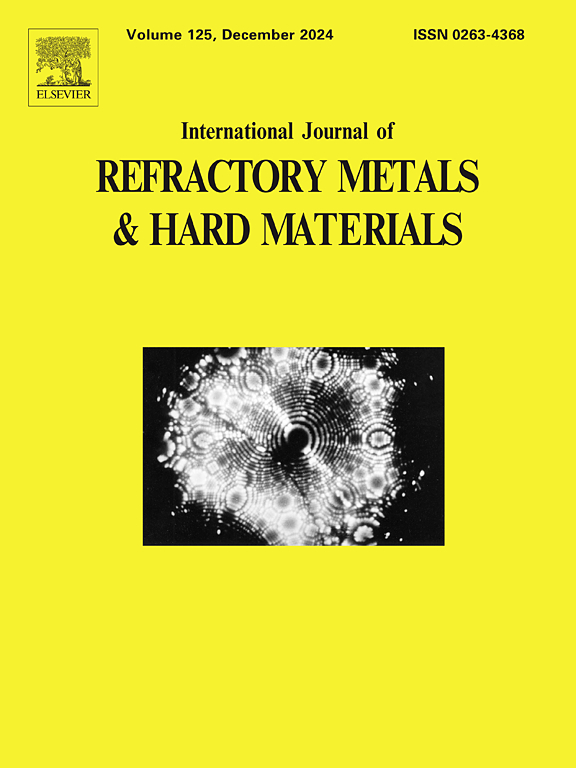Effect of process parameters on microstructure and properties of W-Ti-Zr-Nb tungsten alloy fabricated by LPBF
IF 4.2
2区 材料科学
Q2 MATERIALS SCIENCE, MULTIDISCIPLINARY
International Journal of Refractory Metals & Hard Materials
Pub Date : 2024-10-30
DOI:10.1016/j.ijrmhm.2024.106945
引用次数: 0
Abstract
A novel tungsten alloy with the composition 73W-9Ti-9Zr-9Nb was successfully fabricated by Laser Powder Bed Fusion (LPBF). This study investigates the relationship between process parameters and the microstructure, defects, phases and mechanical properties of the alloy. The results revealed that with an increase in the laser power (P) from 50 to 100 W, the number of unmelted W particles decreased, transitioning the microstructure of the as-fabricated samples from W particles embedded in the Ti-Zr-Nb matrix to W dendrites within the Ti-Zr-Nb-W matrix. Simultaneously, the porosity decreased from 20.1 % to 0.1 % as the P increased. There was no W2Zr brittle phase in W-Ti-Zr-Nb, and the interface between the W particles, W dendrites, and the matrix was well-bonded. the interfaces between the W particles, W dendrites, and the matrix were well-bonded. As a result of these optimized processing conditions, the sample processed at a P of 100 W exhibited optimal overall performance, achieving a microhardness of 612.8 HV and an ultimate compressive strength of 2410 MPa. Increasing the laser power improved the overall performance of the material by reducing defects, increasing the proportion of dendrites, and enhancing solution strengthening.
工艺参数对 LPBF 制备的 W-Ti-Zr-Nb 钨合金微观结构和性能的影响
利用激光粉末床熔融技术(LPBF)成功制造了一种成分为 73W-9Ti-9Zr-9Nb 的新型钨合金。本研究探讨了工艺参数与合金的微观结构、缺陷、相和机械性能之间的关系。结果表明,随着激光功率(P)从 50 W 增加到 100 W,未熔化的 W 粒子数量减少,制备样品的微观结构从嵌入 Ti-Zr-Nb 基体中的 W 粒子过渡到 Ti-Zr-Nb-W 基体中的 W 树枝状。同时,随着 P 值的增加,孔隙率从 20.1% 降至 0.1%。在 W-Ti-Zr-Nb 中没有 W2Zr 脆相,W 颗粒、W 树枝状物和基体之间的界面结合良好。由于采用了这些优化的加工条件,在功率为 100 W 时加工的样品表现出最佳的整体性能,显微硬度达到 612.8 HV,极限抗压强度达到 2410 MPa。提高激光功率可减少缺陷、增加树枝状突起的比例并增强溶液强度,从而改善材料的整体性能。
本文章由计算机程序翻译,如有差异,请以英文原文为准。
求助全文
约1分钟内获得全文
求助全文
来源期刊
CiteScore
7.00
自引率
13.90%
发文量
236
审稿时长
35 days
期刊介绍:
The International Journal of Refractory Metals and Hard Materials (IJRMHM) publishes original research articles concerned with all aspects of refractory metals and hard materials. Refractory metals are defined as metals with melting points higher than 1800 °C. These are tungsten, molybdenum, chromium, tantalum, niobium, hafnium, and rhenium, as well as many compounds and alloys based thereupon. Hard materials that are included in the scope of this journal are defined as materials with hardness values higher than 1000 kg/mm2, primarily intended for applications as manufacturing tools or wear resistant components in mechanical systems. Thus they encompass carbides, nitrides and borides of metals, and related compounds. A special focus of this journal is put on the family of hardmetals, which is also known as cemented tungsten carbide, and cermets which are based on titanium carbide and carbonitrides with or without a metal binder. Ceramics and superhard materials including diamond and cubic boron nitride may also be accepted provided the subject material is presented as hard materials as defined above.

 求助内容:
求助内容: 应助结果提醒方式:
应助结果提醒方式:


